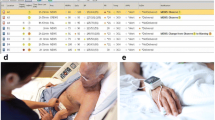Abstract
Objective
To describe the timing of cardiac arrest detection in relation to episodes of Medical Emergency Team (MET) review and routine nursing observations.
Design and setting
Retrospective observational study in a university-affiliated hospital.
Patients
279 cardiac arrests involving ward patients
Measurements and results
Cardiac arrests were allocated to one of 24 1-h intervals (24:00–00:59, 01:00–01:59, etc.). The actual hourly rate of cardiac arrests was related to the expected average hourly rate. Peak levels of cardiac arrest detection occurred during times of routine overnight nursing clinical observations between 02:00 and 03:00 (OR 3.06) and 06:00–07:00 (OR 1.95). The lowest level of cardiac arrest detection occurred between 20:00 and 21:00 (OR 0.42). After introduction of the MET there were 162 cardiac arrests, 28% of which occurred shortly after an initial MET call. The odds ratio for risk of cardiac arrest during periods of lowest MET activation (24:00–08:00) when compared with periods of highest MET activation (16:00–24:00) was 2.26.
Conclusions
Cardiac arrest detection in our hospital is episodic with peak levels corresponding to periods of overnight routine nursing observations following a period when patient review is likely to be low. After the introduction of the MET there was an inverse link between detection of cardiac arrests and levels of MET activation over the 24-h period. Increased overnight utilization and earlier MET activation may further reduce the incidence of cardiac arrests at our hospital.


Similar content being viewed by others
References
Franklin C, Mathew J (1994) Developing strategies to prevent in-hospital cardiac arrest: analyzing responses of physicians and nurses in the hours before the event. Crit Care Med 22:244–247
Shein RMH, Hazday N, Pena M et al. (1990) Clinical antecedents to in-hospital cardiopulmonary arrests. Chest 98:1388–1392
Kause J, Smith G, Prytherch D et al. (2004) A comparison of antecedents to cardiac arrests, deaths and emergency intensive care admissions in Australia and New Zealand, and the United Kingdom—the ACADEMIA study. Resuscitation 62:275–282
Bellomo R, Goldsmith D, Uchino S, Buckmaster J et al. (2003) A prospective before-and-after trial of a medical emergency team. Med J Aust 179:283–287
Buist MD, Moore GE, Bernard SA et al. (2002) Effects of a medical emergency team on reduction in incidence of and mortality from unexpected cardiac arrest in hospital: preliminary study. BMJ 324:387–390
Kenward G, Castle N, Hodgetts T, Shaikh L (2004) Evaluation of a Medical Emergency Team one year after implementation. Resuscitation 61:257–263
DeVita, Braithwaite S, Mahidhara R et al. (2004) Use of medical emergency team responses to reduce hospital cardiopulmonary arrests. Qual Saf Health Care 13:251–425
Jones D, Bates S, Warrillow S, Opdam H, Goldsmith D, Gutteridge G, Bellomo R (2005) Circadian pattern of activation of the medical emergency team in a teaching hospital. Crit Care; available at: http://ccforum.com/content/9/4/R303
Arntz HR, Willich SN, Scheiber C et al. (2000) Diurnal, weekly and seasonal variation of sudden death. Population-based analysis of 24 061 consecutive cases. Eur Heart J 21:315–320
Soo LH, Gray D, Young T, Hampton JR (2000) Circadian variation in witnessed out of hospital cardiac arrests. Heart 84:370–376
Buff DD, Fleisher JM, Roca JA et al. (1992) Circadian Distribution of In-Hospital Cardiopulmonary Arrests on the General Medical Ward. Arch Intern Med 152:1282–1288
DeVita M (2005) Medical emergency teams: deciphering clues to crises in hospitals. Crit Care; available at: http://ccforum.com/inpress/inpress/cc3721
Dumot JA, Burval DJ, Sprung J (2001) Outcome of adult cardiopulmonary resuscitations at a tertiary referral center including results of “limited” resuscitations. Arch Intern Med 161:1751–1758
Herlitz J, Bång A, Björn A, Aune S (2002) Characteristics and outcome among patients suffering from in hospital cardiac arrests in relation to whether the arrest took place during office hours. Resuscitation 53:127–133
Author information
Authors and Affiliations
Corresponding author
Rights and permissions
About this article
Cite this article
Jones, D., Bellomo, R., Bates, S. et al. Patient monitoring and the timing of cardiac arrests and medical emergency team calls in a teaching hospital. Intensive Care Med 32, 1352–1356 (2006). https://doi.org/10.1007/s00134-006-0263-x
Received:
Accepted:
Published:
Issue Date:
DOI: https://doi.org/10.1007/s00134-006-0263-x




